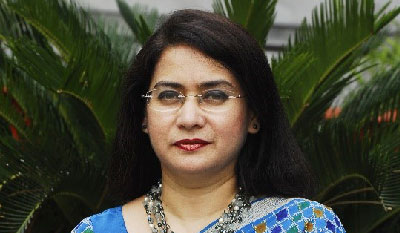Published in ICE Business Time on Sunday 12 January 2020

Dr Fahmida Khatun, Executive Director of the Centre for Policy Dialogue (CPD) shares her opinion about the state of our banking sector, perils of the high unemployment rate and the challenges that lie ahead for our economy.
As we step into the new decade, what is the biggest challenge that lies ahead for our economy?
Our domestic resource generation has become a major challenge, especially in view of high development expenditures. Despite the high growth of gross domestic product (GDP), the tax-GDP ratio in Bangladesh is the lowest in South Asia. This trend of the shortfall from the targets has started since FYI 2012. The short-fall of revenue –GDP ratio is now on an increasing trend. Our tax-GDP ratio is even lower than the average ratio in the Least Developed Countries (LDCs) where it was about 15 percent in 2017. We are about to complete the tenure of the Seventh Five Year Plan (7FYP). In the 7FYP the Revenue-GPD target is set at 16.1 percent revenue-GDP ratio and tax-GDP at 14.1 percent by FY 2019-2020. It is now unlikely that these targets of 7FYP will be fulfilled.
Efforts towards the generation of revenue through higher direct taxes should be the priority. We are gradually becoming dependent on indirect taxes which are inequitable and discriminating towards the lower-income groups. We have not seen an effective implementation of the new Value Added Tax (VAT) law. Initiatives are needed for the expansion of tax net and reduction of tax avoidance. The National Board of Revenue (NBR) should not only target the fixed income salaried people who are already in the tax net, but also the large tax evaders whose incomes are not always accounted for. The NBR has to be fully automated and human resource development should be an ongoing process.
Bangladesh’s ranking in the soundness of banks is the lowest among the South Asian countries, what are the factors that lead the sector to this state? How will the fallout affect the government?
The banking is in shambles at the moment. The amount of non-performing loans (NPLs) has been increasing continuously. On top of it, the practice of writing off and rescheduling of bad loans is also increasing. Several policies have been undertaken in 2019 which are not going to help improve the health of the banking sector, rather benefit the loan defaulters. Those are taking the banking sector backwards. All good practices are being scrapped one after another in the banking sector. The independence of the central bank has been undermined by external influence. All banking policies are being devised under the directives of the powerful and groups.
In June 2019, the total share of NPL was as high as 11.69 percent of total outstanding loans. On the other hand, the banking sector is facing a liquidity crisis. Domestic credit to the private sector has also been below the target of Bangladesh Bank. On the other hand, government borrowing from the banking system has been on the rise due to low revenue generation and underwriting the high expenditures of several mega projects. The cost of these megaprojects has escalated over time due to weak accountability and transparency. Therefore, on the one hand, low revenue generation and on the other hand, high bank borrowing by the government are going to have serious ramifications on the government’s fiscal management.
Currently, Bangladesh’s youth unemployment rate is 10.6 percent, more than two and a half times the national average. How can this issue be best addressed?
High economic growth has not been able to create enough jobs in the economy. Particularly, the youth have not been able to find suitable jobs despite university and college degrees. One of the features of our growth has been that, surprisingly, growth has been achieved despite low private investment. Indeed private investment has been stagnant at around 23 percent of GDP for the last couple of years. Hence without any private investment, the economy could not create adequate jobs.
More worrying, the higher the education level, the higher the unemployment level. The other feature is that though there are some demand for workforce in the economy, employers do not find our educated youth suitable for those jobs. This implies that there is a mismatch between the demand of the employers and the supply of graduates. This emphasizes the need for modernising our education system in line with the need of the market. On the other hand, our economy is not large enough to accommodate each and every job seeker. Therefore, opportunities for self- employment have to be created. Youths who want to be entrepreneurs should be provided with training and access to finance. Sadly, while thousands of crores are being siphoned off from the banks by loan defaulters, banks show little interest to provide loans to new small entrepreneurs.



